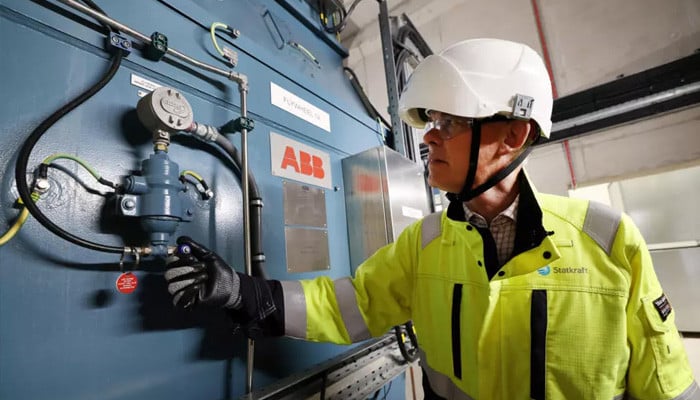The energy operator of Great Britain gambles on an age-old technology to make its grid future-proof, because the power plants that have traditionally helped are closed and replaced by renewable energy systems.
Spinning metal devices known as flywheels have been used for centuries to offer slowness – resistance to sudden changes in motion – to various machines, from a Potter’s wheel to the steam engine.
Raster operators are now looking at the technology to add slowness to renewable heavy electricity systems to prevent blackouts such as those of Spain and Portugal this year.
In an electricity network, slowness is generally provided by large spinning generators found in coal-fired and gas factories, which maintains a constant frequency by smoothing out fluctuations in supply and demand.
But renewable energy sources such as solar and wind energy do not add slowness to the grid, and cannot usually help with other problems, such as voltage control.
Flywheels can simulate the rotation of energy plant generators, run faster or slower to respond to fluctuations.
Without rotating turbines, “the system is more susceptible to fluctuations than usual,” explained David Brayshaw, a professor of climate science at the University of Reading in England.
“As we get higher and higher levels of renewable energy sources, we have to think about this better,” Brayshaw told AFP.
Flight wheels and batteries
The Iberian Peninsula, which is driven by a high part of renewable energy sources, became dark on April 28 after the grid was unable to absorb a sudden increase in tension and deviations in frequency.
Since then, the Spanish government has focused fingers on conventional power plants for not controlling the voltage levels.
It could serve as a wake-up call comparable to a failure of 2019 that collapsed parts of Great Britain in the darkness after a drop in grid frequency.
That black-out led the British energy operator Neso to launch what it called a “world-first” program to contract Grid-stabilizing projects.
Flywheels and batteries can add synthetic slowness to the grid, but technical professor Keith Pullen says that steel flywheels can be more cost-effective and more durable than lithium ion batteries.
“I am not saying that flywheels are the only technology, but they can be very, very important,” says Pullen, a professor of City St George’s, University of London and director of the Startup Levistist.
In the coming years, Pullen warned that the grid will also become more unstable due to a larger one, but the demand from the Spikier.
With electric cars, heat pumps and energy-guzzling data centers that are connected to the grid: “We will have more shock loads … that smoothes the flywheel”.
Carbon -free slowness
The “Greener Grid Park” of Norwegian Company Statkraft in Liverpool was one of the projects contracted by Neso to keep the lights.
Operational since 2023, it is a stone’s throw from a former coal-fired power plant that loomed over the Northern England city most of the 20th century.
But now, instead of steam turbines, two gigantic flight wheels with a weight of 40 tons (40,000 kilograms) weigh every whirr on the Statkraft site, which delivers 1% of the slowness for the grid needed in England, Scotland and Wales.
Each flywheel is attached to a synchronous compensator, a rotating machine that further stimulates slowness and offers voltage control services in the Liverpool region.
“We offer that slowness without burning fossil fuels, without creating carbon emissions,” said Guy Nicholson, main solutions of Statkraft’s Zero-cabbage grid.
According to Neso, 11 other comparable synchronous compensator and flywheel projects were operational in Great Britain from 2023, with even more contracted.
‘Not fast enough’
The government works “closely with our industrial partners who develop-leading technology worldwide, including fly wheels, static and synchronous compensators, while we revise the energy system,” a word security and spokesperson for Net Zero told AFP.
But: “We don’t build them fast enough to decipher the schedule,” Nicholson warned.
Great -Britain wants to feed the schedule of strength 95% of the time in 2030 of clean energy before they completely switch to renewable energy sources in the following decade.
“At the moment … we can’t even do it for an hour,” said Nicholson.
Even when enough solar and wind energy is generated, “we still have to walk guest turbines to keep the grid stable,” he explained.
Nevertheless, Great Britain and neighboring Ireland seem to be ahead of the curve in purchasing technology to stabilize renewable heavy grilles.
“In GB and Ireland, system operators are leading by increasing these services,” said Nicholson. “On the continent there was not the same drive for that.”
“I think these things will be powered by events. So the Spanish blackout will change.”








